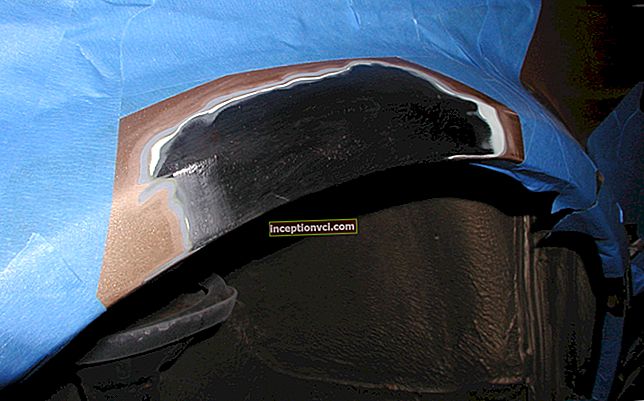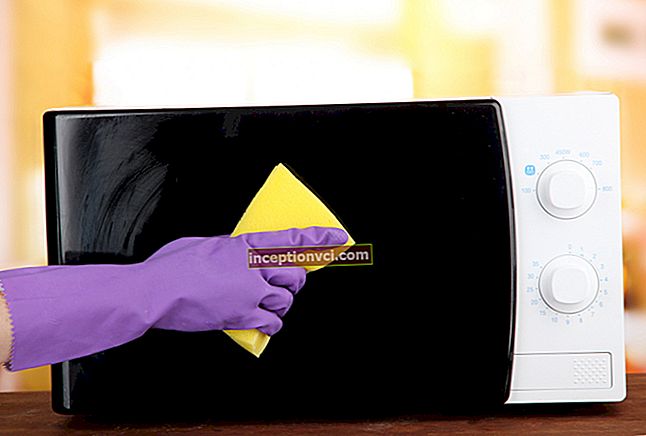A few weeks ago, the well-known company Apple unveiled its new iPad, which received an impressive Retina display with a resolution of 2048 by 1536 pixels, a powerful hardware component of the Apple A5X, an enhanced power supply and an advanced 4G module. For some reason, the manufacturer called the new product “The New iPad”, and no more logical name, like iPad 3, iPad HD, or iPad 4G.
Contents of delivery
The new iPad comes in a standard white package for this brand (everything is very tightly packed). At first glance, it may seem that this box completely repeats that in the previous version of the iPad, it has the same width and height, but there is also a significant difference in it.

The increase in thickness by only 0.6 mm, for some reason, entailed a thickening of the box itself by a whole centimeter! The meaning of this operation is not very clear, from a logical point of view the situation has deteriorated a little, but the marketing message is read perfectly - “buying a new iPad you get more for the same price”.

For those who think that they would not slip an "old" iPad instead of a new one, the following distinctive features of the packaging can be distinguished:
- there is a photo of the tablet on the top of the box, for both cases the same angle is used, but the screen of The New iPad has a different wallpaper - instead of the usual grayish drops of water, ripples with a more pronounced blue transition.
- at the bottom, instead of the notorious bitten apple, you can see the shiny logo of the iCloud service.
- well, the main proof - two stickers with designations of configurations on the back of the box. On the left side it is the 4G module label and the amount of memory, on the right - the model designation and batch number. The New iPad is indeed marked as a simple “iPad”, you can distinguish it by the “part number” of the form MDxxx (in the previous version you could see the designation Mcxxx).

Let's go directly to the very unboxing of the new iPad. Everything inside is unchanged, the tablet itself is wrapped in a transparent plastic film and located in a small recess.

Other accessories are in the compartments of the plastic pallet, in the middle: a tiny paper envelope with a small instruction manual, a clip for removing a Micro-SIM card (in versions supporting 4G) and two "apple" stickers (without them, they are not accepted into the sect); 30-pin / USB cable (proprietary connector); Charger.

In the US package of the new iPad, the charger fits into one niche, while European consumers needed two (the European plug has no moving mechanisms and remains one piece).

I would like to say that almost all "native" for SmartCover are fully compatible with the new iPad, problems arise only when using too narrow cases from third-party manufacturers.
The design of the new iPad
As you know, Apple loves to keep the design of its devices in the strictest confidence until the last minute, if a few information leaks happen, they are almost never 100% confirmation of the facts. Just a couple of days before the announcement, photos of some parts of the iPad 3 case appeared on the Internet, which indicated that the brainchild would become noticeably thicker. Most of the fans of this tablet did not believe these pictures, although in the end they turned out to be true.
The first rumor about the updated design was started by Apple itself, sending out invitations to the presentation with a photo of the border of the new iPad without the traditional Home button. Indeed, at the moment the functionality of this hardware button can be replaced with some kind of gesture, but in some cases (for example, when taking screenshots) you cannot do without it.Due to the fact that the information was provided directly by the manufacturer himself, many believed that they would get rid of the button, although in fact it was a photo of the side, not the bottom of the bezel.

The new iPad shares the same design as the second generation model. The solution will not appeal to users who would like the "bourgeois" model in their hands to be unambiguously recognized by those around them. However, it is no secret to anyone that Apple does not want to change the successful design of devices for at least two generations, and in some cases even longer - a clear example of this is the MacBook Air. Many people like this approach much more than the annual search for a new design, so it's stupid to classify the previous design as a shortcoming.

Thanks to the use of a more capacious battery, the thickness of the tablet has increased by only 0.6 mm, and I cannot call such a change a noticeable one. It is almost impossible to assess the increased thickness by eye, for this you can lay two tablets side by side on a flat surface and look out for the difference for a long time. But the increase in weight by 50 grams, compared with the second generation, is noticeable even without weights. Interestingly, this increase did not bring the total weight of The New iPad to the level of the first generation tablet (remember, it was 30 grams heavier). During operation, you quickly get used to the weight, it cannot be called too weighty, but the fact remains - with each generation, competitors are losing weight, and the iPad had to get a little fat.

For those who are not at all familiar with the early models of Apple iPad tablets, we will briefly list the features of its design. The front panel is completely covered with protective glass, the hardware button "Home" is located below, and an additional camera is on top. The bezel of the 9.7-inch screen is quite wide, which allows you to comfortably hold the tablet with your hands without touching the touchscreen. There is a white and black version of the tablet design, but this only applies to the front panel - in both cases, the base of the case is made of aluminum.

The back panel and smoothed sides of the new iPad are, in the old fashion, made in the form of a common aluminum part with a shiny apple in the center. The right part contains the combined buttons for adjusting the volume of the sound and the slider "Mute", which can be used to block the automatic change of the screen orientation (fixed in the portrait position). In 4G versions, on the left side you will find a compartment for a micro-SIM card, and on top there is a black plastic cover under which the antenna of the mobile communication module is hidden. Also, the power activation button and a standard headphone jack have found their place on top. At the bottom there is a single speaker (stereo sound is possible only when using headphones) and a 30-pin proprietary connector.

This interface is fully compatible with early Apple devices, but its design has been significantly strengthened. It is easy to guess that in this way the developer decided to increase the reliability of this element due to the increased weight of the device. So, what changes await us? In the metal case of the second iPad, there is an interface hole with a plastic inner part (with the exception of contacts). But in the new iPad, the receiving part of the interface is a single whole with the rest of the body, it is a kind of aluminum trough. In addition, the guides along which the plug goes inside are also made of metal, and only the central tongue containing the contacts is made of plastic for obvious reasons.
Logically, you can understand that the design of The New iPad is not conducive to the transition of the second iPad user to the 3rd generation. However, this cannot be said about the improved hardware platform, and most importantly, the Retina screen (which will be discussed in the next section of the review), any person keen on technical progress will want to buy it.
New iPad display
The New iPad's screen isn't just good, it's gorgeous. There is no point in wasting your time sorting out epithets.With the 9.7-inch Retina display and the staggering 2048x1536 (264 dpi) resolution, the screens of the rest of the tablets instantly become coarse-grained and soapy, as if you had very poor eyesight and forgot to wear glasses. The image reads like a magazine with excellent color printing.

The display resolution of the new iPad is higher than that of the current Full HD TVs with an indicator of 1920 × 1080 pixels, and of course, higher than that of any tablet currently on sale. While the only supposed competitor to this model is the Galaxy Tab 11.6 in development, it will be powered by an ARM Cortex A15 processor and feature an 11.6-inch display with an even higher resolution of 2560x1600. Although, even in his case, the pixel density remains at the same level as that of The New iPad due to the larger screen size - about 260 pixels per inch.


By the way, a clear example of "changing reality" from Apple - initially the manufacturer assured that the right to bear the name Retina deserves only displays with a pixel density of at least 300 PPI (fourth generation iPod with 326 PPI). Despite this, with the announcement of the new iPad, it turned out that you need to consider not only the actual density, but also the distance between your eyes and the device's screen. And since you, of course, do not hold a larger tablet in front of you as close as a smartphone with a 3.5-inch screen, the relative number of pixels per inch of the new iPad just fits into the Retina frame. Everything is elementary, isn't it? The one who sets the rules changes them.
The matrix manufacturing technology has not changed, it is the same well-proven IPS, combining large viewing angles with a realistic color gamut. These displays are inferior to competing AMOLED technologies in terms of saturation, image contrast, and the choice between them depends solely on the personal preferences of a particular user - someone will like the naturalism and softness of IPS, while others prefer bright, sharp AMOLED colors.


During testing, the displays of Apple iPad tablets of all generations were compared, this made it possible to visually observe the evolution of picture quality. So, the displays of the first two generations are completely identical in characteristics, but the iPad 2 performed slightly better when viewed from an angle - a higher contrast is noticeable and the complete absence of a parasitic purple fill, which is very noticeable in the first generation iPad. Comparison of iPad 2 and The New iPad showed not only significantly improved detail, but also a warmer gamut of the latter, so the screen is not only a way to lure the buyer with large numbers - the display of the new product is good in all respects (brightness range, oleophobic coating, recognition accuracy capacitive sensor).
Apps for the new iPad
I would like to remind you that to maintain compatibility with existing applications, Apple engineers increased the screen resolution proportionally. Unremarkable at the moment, the resolution of 1024 × 768 pixels (132 PPI) has been increased to an “incredible” 2048 × 1536 (264 PPI), as a result the image size has doubled and the number of pixels has quadrupled. It turns out that the old software works with the new tablet without problems, but you will get visual pleasure only when using applications optimized for Retina.

The difference in detail is clearly visible on the example of pre-installed application icons. In "Contacts" even the smallest letters are perfectly readable, in "YouTube" the microphone grille has clearly traced risks and, finally, the flower petals on the "Photo" icon can be counted without much difficulty. When surfing the Internet in Safari, small letters remain readable in places where the second iPad showed blurred spots. Most sites can be read without problems even in vertical orientation, the smallest elements are perfectly distinguishable and without scaling. Separately, let's talk about the quality of font rendering in the popular iBooks application.If earlier you unconsciously increased the font in order to avoid pixelation of characters, now you can choose a smaller scale - the text looks crystal clear, as if it were drawn by hand.

Angry Birds Rio, Real Racing 2 HD and Sky Gamblers: Air Supremacy were installed to evaluate the quality of the graphics. The last two projects have already been redesigned for the Retina display and look great on the screen of the new iPad, the degree of realism and detail is simply mesmerizing. On the test iPad of the second generation in the same games you can easily see the notorious "saw" on the diagonals, but on the new tablet, such artifacts are completely absent. The developers of Angry Birds did not have time to remake their brainchild for high resolution, and therefore this toy became a litmus test in the study of the display difference. As expected, launching an unoptimized game transforms the glorious Retina display into a legacy display.

Someday all popular software and game manufacturers will release updates to their applications, which will inevitably lead to a corresponding increase in the size of distributions. Thus, when using the youngest version of The New iPad, you simply may not have enough space for the standard set of programs, and Apple still has not offered 128 GB of memory. I would like to highlight two sets of great native apps for entertainment and work - we are talking about iLife (iMovie, iPhoto, and GarageBand) and iWorks (Keynote, Pages and Numbers).
Hardware platform of the new iPad
The rumor that The New iPad will be built on a 4-core A6 processor had been around long before the tablet was first announced. At the same time, there was a seemingly iron argument - the screen resolution has doubled, which requires much higher performance. And giving odds to competitors from Android, purposefully mastering the 4-core NVIDIA Tegra 3 from the point of view of marketing, is not too correct.
However, here, too, Apple has shown that it does not care about the trends of the mobile market and competitors. It was decided to add cores to the processor, but not to the computing part, where, as before, a pair of ARM Cortex-A9 with a frequency of 1 GHz works, but to the graphics system, building it on a pair of 2-core PowerVR SGX543MP4 graphics accelerators. It turns out that the formula for the new Apple A5X can be represented as two computing cores + 4 graphics. Interestingly, Tegra 3 has as many as 17 cores (four computing, one paired and twelve graphics) and at the same time at the presentation people from Apple said that their system has faster graphics performance.

The Apple A5X system is manufactured using 45nm technology. Of the main architectural solutions, it should be noted the transfer of RAM outside the processor. The new iPad's RAM has a capacity of 1 GB and consists of two separate 512 MB microcircuits located on the circuit board (in previous systems of the company, the RAM was directly in the single-chip system).
Thus, Apple was forced to use a more productive (and, therefore, power-intensive) hardware component, which provides sufficient performance when working with graphics at double the resolution. The increase in power consumption was also heavily influenced by the 4G retina module, so in order to maintain a 10-hour battery life, Apple had to figure out how to increase the battery capacity. As you already know, the developer coped with the task perfectly, the thickness increased by 0.6 mm and the weight gain of 50 grams are instantly forgotten when you realize that the new iPad has a 42.5 Wh battery, while almost all competitors have typical batteries. at 25 Wh.
The main technical characteristics of the new iPad are listed in the table, in addition to an increase in RAM and a new processor, it is imperative to mention the presence of a 4G module that is still irrelevant for our country, which can only work with us as 3G.
Autonomy and performance
Before moving on to different testing numbers, let's talk about the general impressions after working with The New iPad. The fact is that during everyday use, there is not a significant increase in performance, some applications run a little faster on the third iPad, others - on the second. But, in general, they work with approximately the same responsiveness. There is not even a trace of a very noticeable jump in speed observed during the transition from the first generation to the second.
At the same time, an interesting pattern is observed: applications and games not optimized for Retina on the new iPad run faster than on the old one, but they look exactly the same, due to the usual stretching of the original images. Apparently, this is due to the doubled amount of RAM and the better performance of the A5X platform. But optimized applications (for example, Sky Gamblers), on the contrary, usually load on the new iPad much longer, expanding more detailed polygons, while the second iPad, apparently, works with SD content. At the same time, small delays at launch more than pay off with improved graphics on the screen and high details, but the fact remains that the new iPad is not always faster than its predecessor. This statement is clearly demonstrated by the summary table of test results. It can be seen that the level of performance of the last two tablets is almost identical.

There is no point in talking about the real battery life of the iPad, as mentioned above, Apple promised users 10 hours of autonomy and kept its promise. The maximally charged batteries run down according to a similar schedule. But when the critical charge level was reached, a small problem emerged. The battery of the novelty has 1.7 times the capacity (42.5 Wh versus 25 Wh), but is equipped with the same standard 10-watt charger. Thus, The New iPad takes much longer to charge compared to iPad 2 - be sure to consider this point.
It's hard not to notice the significant overheating of the back cover (and some of the screen) during active use - this is a kind of payment for a display with a higher resolution and increased performance. Basically, the left side of the case heats up, it is there that the circuit board with the processor and other heating components is located. Apparently, Retina has a significant impact on the temperature of work, since lowering the brightness of the backlight to some extent corrects the situation. It is likely that the battery is also contributing. The temperature cannot be called “scorching”, but the heating is higher than that of the second generation (the first iPad can be called cold without a twinge of conscience).
Camera of the new iPad
The new tablet is equipped with two cameras at once, front (for communication) and the main 5-megapixel, called iSight. The latter is built on the same Omnivision CMOS sensor as in the iPhone 4, but it uses a completely new optical system, assembled from 5 lenses. The camera supports automatic focus on tap on the display, detects faces in the frame and can record stabilized HD video in 1080p quality at 30 frames per second.
The quality of images and videos obtained with the iSight camera is quite high, it is quite easy to make sure of this, you just need to use a search engine. If you intend to actively use the photographic capabilities of the new iPad, then be sure to try the capabilities of the new iPhoto photo editor, which you can buy in the AppStore. One way or another, the process of shooting with a large 10-inch tablet has many contradictions, although the presence of a sufficiently high-quality camera in this format is better than none at all.
Using the new iPad
Each section of this review was devoted to the nuances that arose in the course of testing the functions of the new iPad, so here is just a summary.
Since the construction and design of the new tablet have remained unchanged, the ergonomics of the device are also at the same level.That is, the mechanical controls located on the rounded sidewalls are inconvenient to use (especially when installing the SmartCover). A monaural multimedia speaker is still used, I don't think anyone would be against stereo sound.

There are no operators in our country yet that support the high-speed LTE mobile communication standard. 3G is the maximum you can count on. Voice text input does not work in Ukrainian and Russian, and does not have as wide functionality as Siri on iPhone.

And finally, I would like to remind once again about the "hot temper" of the new iPad, at the moment it is not known what consequences the problem of overheating of the device may have. The tablet recently went on sale, and the statistics of this situation have not yet been collected, but in any case, a potential buyer should not ignore this fact.
Summarizing
Everything in the new iPad is built on a Retina display. For his sake, the manufacturer was forced to use a powerful processor, which led to the installation of a more capacious battery and to some extent increased the heating, weight and thickness of The New iPad. The system performance of the tablet has increased slightly, the autonomy has slightly dropped, and a significant increase in the speed of three-dimensional graphics is almost completely suppressed by the new display with a unique high resolution. In Ukraine, there is no point in the 4G module, and the improvement in camera performance is hardly one of the critical advantages of The New iPad.
However, all these shortcomings (it is difficult to call them shortcomings) are quickly forgotten when you see the excellent image quality and the maximum level of detail of the Retina display that none of the existing competitors can provide. Thus, it makes sense to buy a new iPad at this stage if the process of working with the tablet screen prevails in the list of your requirements - if you are an enthusiastic photographer, an avid gamer, a geek or a picky wireless Internet user. Casual tablet users may not notice the improvement in image quality, and purchasing a discounted 2nd generation would be a much more logical purchase.
Benefits
+ Retina display with the highest resolution so far (2048 x 1536 pixels)
+ new modified A5X processor - two processing and four graphics cores, as well as 1 GB of RAM
+ 1.5 times increased battery capacity, which made it possible to keep the battery life at the same level
+ prices for main configurations remain the same
+ improved camera (5 MP), new optics installed
disadvantages
- the screen and aluminum back panel get very hot
- the battery charges almost 1.5 times longer than the second iPad
- Optimization of applications for the Retina display led to an increase in the occupied space
- New iPad is thicker and heavier than its predecessor









